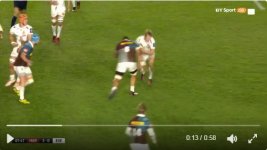Ok, so that's the 10 standing upright vs the moment of contact. Minimal duck?
He's 6 foot 1. Average femur length 19 or 20 inches in an average male. That's a huge difference! As you can see, there is 1 second difference.
Firstly - he is full extended in the first photo (almost in the air). The running motion, and the push off, mean he needs to bend his legs. This is normal, and should be expected. This natural motion lowers the upper body. The second shot is AFTER the contact. He is already folding up at this point. And the "ducking" motion most people refer to - is actually the white player instinctively curling up to protect themselves. (It is not the "ducking" you see when a player is about to go into contact, to try and drive through for example). The player here is not "ducking" into contact in my opinion, he is curling up for protection.
You go high, you lead with the shoulder, you take 100% responsibility for the outcome.
However you look at it - the "tackle" resulted in a shoulder charge to the head. That is red everytime.
- - - Updated - - -
Ok, so that's the 10 standing upright vs the moment of contact. Minimal duck?
He's 6 foot 1. Average femur length 19 or 20 inches in an average male. That's a huge difference! As you can see, there is 1 second difference.
Firstly - he is full extended in the first photo (almost in the air). The running motion, and the push off, mean he needs to bend his legs. This is normal, and should be expected. This natural motion lowers the upper body. The second shot is AFTER the contact. He is already folding up at this point. And the "ducking" motion most people refer to - is actually the white player instinctively curling up to protect themselves. (It is not the "ducking" you see when a player is about to go into contact, to try and drive through for example). The player here is not "ducking" into contact in my opinion, he is curling up for protection.
You go high, you lead with the shoulder, you take 100% responsibility for the outcome.
However you look at it - the "tackle" resulted in a shoulder charge to the head. That is red everytime.








